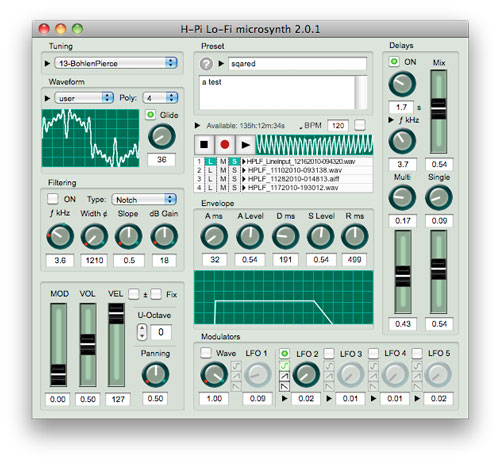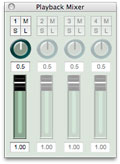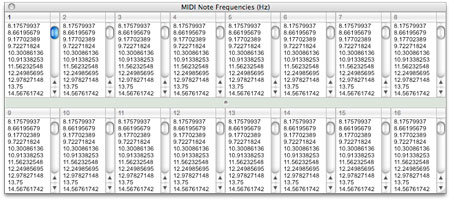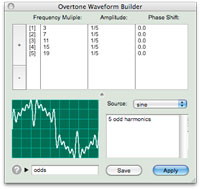



January 17, 2011

It's been quite a while since the initial release of the H-Pi Lo-Fi Microsynth for MacOSX, and high time for an update. Not only has overall output and performance been improved in HPLF2, but many new features have been added to make HPLF a much more versatile and useful tool for microtonal composition.
New features include a filter bank, multi-delay reverb unit, and a bank of assignable LFO modulators. Basically, this means that HPLF is no longer just a raw waveform generator. HPLF2 has a little more refined style, maybe even some penache. Through the process of programming HPLF2, I've become more convinced than ever that a little filtering and delay can really go a long way in terms of output palatability. The sounds of HPLF2 are much more attractive than those that came from HPLF. Of course, if you want the old crunchiness, you can just turn the filter and delay off.
One small complaint I got about HPLF was that there was no way to get any sound out of it except through MIDI. So, I added a floating keyboard window that allows you to hear the output using mouse clicks.

Another complaint I got was that HPLF output could not be easily recorded and mixed with other audio. System Audio had to be captured with a utility like JackOSX, and editing had to be done in another application, like Logic. This led to the idea that with HPLF2 you should not only be able to record output, but also edit that output and mix it with other audio without having to open another application.

 So, output can now be streamed to a .wav or .aiff file, and HPLF2 has a full featured audio editor built in, allowing you to do all the typical manipulations, and some not so typical things as well. Essentially, HPLF2 is also now a multi-track recording utility. You can load up to 4 tracks of audio, and mix them along with your playing. Tracks can be looped, panned, soloed, muted, and attenuated. You can record output from the synth, and within the editor you can also record directly from a microphone. Edit the results, set loop points, add fades, change the gain, reverse audio, find fundamental frequencies, and more.
So, output can now be streamed to a .wav or .aiff file, and HPLF2 has a full featured audio editor built in, allowing you to do all the typical manipulations, and some not so typical things as well. Essentially, HPLF2 is also now a multi-track recording utility. You can load up to 4 tracks of audio, and mix them along with your playing. Tracks can be looped, panned, soloed, muted, and attenuated. You can record output from the synth, and within the editor you can also record directly from a microphone. Edit the results, set loop points, add fades, change the gain, reverse audio, find fundamental frequencies, and more.
Along with all these new features, HPLF2 retains the basic microtonal utilities of the original release. Tunings can still be specified across the entire MIDI range (unique tunings per channel, totaling 2048 available pitches). HPLF2 reads both .csv and new .hz files, exported from the free Custom Scale Editor (CSE). The new .hz file format is just a text file with a list of Hz values expressed as decimals, such as 440.00 (which would be tuning pitch A4). The list must be 128 entries (one MIDI channel), 512 entries (4 MIDI channels), or 2048 entries (16 MIDI channels) long. The first option is for basic MIDI work, the second is the default for working with layers in CSE for tunings loaded onto a TBX1 Tuning Box, and latter is standard format for Tonal Plexus keyboards.

 The Overtone Waveform Builder still allows creating harmonic or inharmonic timbres by specifying multiples of a fundamental frequency, with amplitude and phase shift for each component of the waveform, with an optional written description of and preset name for your creation.
The Overtone Waveform Builder still allows creating harmonic or inharmonic timbres by specifying multiples of a fundamental frequency, with amplitude and phase shift for each component of the waveform, with an optional written description of and preset name for your creation.
I hope you'll notice an improvement in the aesthetics of the user interface; the widgets have been given a makeover, and the added features in the layout make the thing more interesting to look at. But, a software synthesizer stands or falls on its sound, not its looks. So what does HPLF2 sound like? Well, soon you'll get to try it out for yourself, but for now, here's a little sample improv mp3.
[ Showing 1 entry | Previous entry | Next entry | Show all entries ]